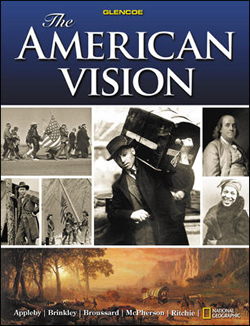The American Vision © 2008Chapter 10:
ReconstructionWeb Lesson PlansIntroduction
Students have read about the economic and social turmoil that permeated the South following the Civil War. In this activity they will examine the challenges that one Southern state faced during the Reconstruction Era.
Lesson Description
Students will use information from the Louisiana State Museum Web site to learn about the challenges Louisiana faced after the Civil War. They will read about Louisiana's post—Civil War social and economic problems, the challenges of the Freedman's Bureau, the Louisiana Constitution of 1868, and the political climate during Reconstruction. Students will also view historical prints, photos, and artifacts that tell the story of Louisiana's Reconstruction era. They will then answer four questions and apply this information by creating a mural that depicts Louisiana during Reconstruction.
Instructional Objectives- Students will analyze the social, economic, and political impacts of Reconstruction policies on white and African American citizens of Louisiana.
- Students will be able to use this knowledge to create a mural that depicts Louisiana during Reconstruction.
Student Web Activity Answers- Many of Louisiana's white citizens were unwilling to accept defeat after the Civil War. They resented Union authority, advocated white supremacy, and sought vindication for Southern deaths. Racial tensions grew as freed persons fought for African American men's enfranchisement. In addition, economic conditions made it difficult for freed African Americans and many whites to purchase land. Many former slaves moved to urban areas, taxing the cities' public services and housing. Plantation owners felt the economic losses of war as well, as homes were bombed or destroyed and land seized by the Union.
- Agents for the Freedman's Bureau worked to solve labor disputes, protect freed persons from violence and re-enslavement, operate schools for African Americans, and distribute food, clothing, and fuel. Limited by financing and manpower, agents primarily served as moderators of disputes. They had no official power to address social or economic problems.
- The Louisiana Constitution of 1868 granted voting and civil rights to African American men, provided for integrated and free public schools, and guaranteed African Americans equal access to public accommodations. In addition, it removed the Black Codes of 1865 and property qualifications for holding public office. Former Confederates were disenfranchised. Racial attitudes prevented real changes to the established social order, however, and African Americans lacked the economic and political power to successfully challenge discrimination.
- Post–Civil War Louisiana saw political struggles between Radical Republicans and those who advocated white supremacy as the tenet for public policy. Louisiana's Constitution of 1864 abolished slavery and disposed of the old planter aristocracy, but it failed to provide freed African Americans with a political voice and public schools. When the state adopted the Black Code of 1865, Radical Republicans intensified their efforts to employ their Reconstruction policies. Sometimes disputes between Radical Republicans and Democrats erupted into violence. The Colfax Riot, the Coushatta Massacre, and the Battle of Liberty Place were demonstrations of the racial and political tensions between Democrats and the Radical Republicans. After the 1872 and 1876 gubernatorial elections, both Democrats and Republicans claimed victory and established dual governments. Republicans maintained power throughout the remaining years of Reconstruction, but they lost power after President Hayes released the Louisiana government from military occupation.
- Students' contributions to the class mural will vary.
 | 




